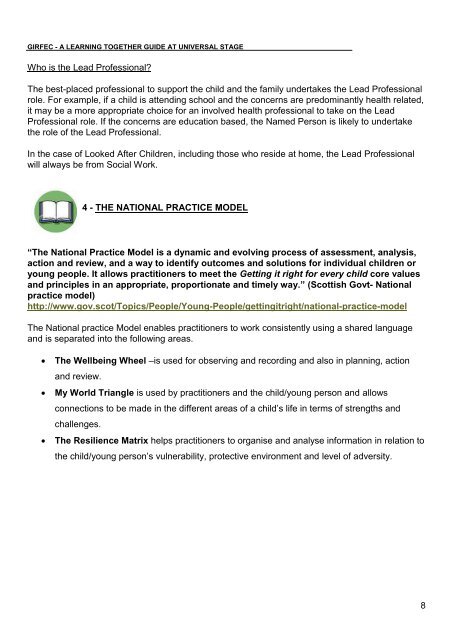Learning Together GIRFEC Getting It Right For Every Child
Learning-Together-Guide-GIRFEC
Learning-Together-Guide-GIRFEC
You also want an ePaper? Increase the reach of your titles
YUMPU automatically turns print PDFs into web optimized ePapers that Google loves.
<strong>GIRFEC</strong> - A LEARNING TOGETHER GUIDE AT UNIVERSAL STAGE<br />
Who is the Lead Professional?<br />
The best-placed professional to support the child and the family undertakes the Lead Professional<br />
role. <strong>For</strong> example, if a child is attending school and the concerns are predominantly health related,<br />
it may be a more appropriate choice for an involved health professional to take on the Lead<br />
Professional role. If the concerns are education based, the Named Person is likely to undertake<br />
the role of the Lead Professional.<br />
In the case of Looked After <strong>Child</strong>ren, including those who reside at home, the Lead Professional<br />
will always be from Social Work.<br />
4 - THE NATIONAL PRACTICE MODEL<br />
“The National Practice Model is a dynamic and evolving process of assessment, analysis,<br />
action and review, and a way to identify outcomes and solutions for individual children or<br />
young people. <strong>It</strong> allows practitioners to meet the <strong>Getting</strong> it right for every child core values<br />
and principles in an appropriate, proportionate and timely way.” (Scottish Govt- National<br />
practice model)<br />
http://www.gov.scot/Topics/People/Young-People/gettingitright/national-practice-model<br />
The National practice Model enables practitioners to work consistently using a shared language<br />
and is separated into the following areas.<br />
<br />
<br />
<br />
The Wellbeing Wheel –is used for observing and recording and also in planning, action<br />
and review.<br />
My World Triangle is used by practitioners and the child/young person and allows<br />
connections to be made in the different areas of a child’s life in terms of strengths and<br />
challenges.<br />
The Resilience Matrix helps practitioners to organise and analyse information in relation to<br />
the child/young person’s vulnerability, protective environment and level of adversity.<br />
8


